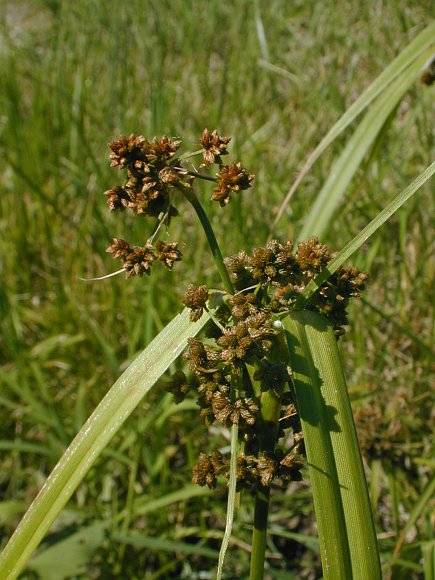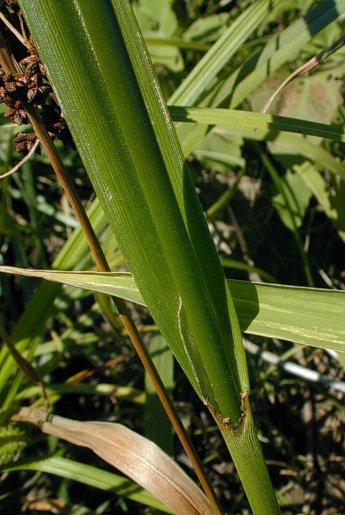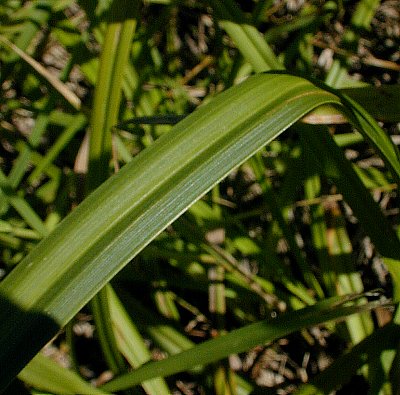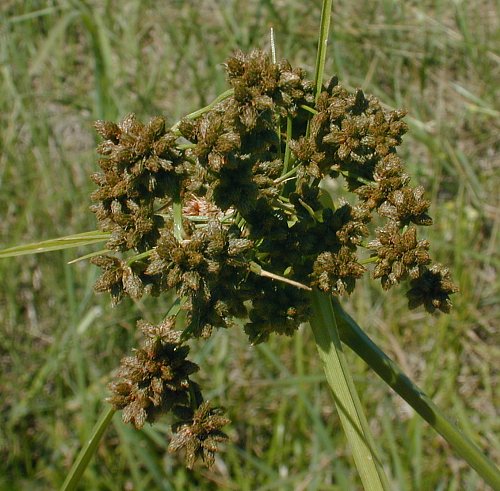Description: This perennial plant is about 2½–4' tall, unbranched, and more or less erect. The culm is green, glabrous, and terete. There are up to 8 alternate leaves along the entire length of the culm. The leaf blades are up to 1½' long and ¾" (19 mm.) across; they are yellowish green to dark green, glabrous, linear in shape, flattened, furrowed along the middle, and rough-textured along their margins. These blades are arching or rather floppy. Leaf venation is parallel; on some leaf blades, there are observable cross-veins connecting the parallel veins at short intervals along the blade (septate). The sheaths are light green to green, glabrous, septate, and closed. The culm terminates in an inflorescence consisting of 1-3 (rarely 4-5) compound umbels of spikelets. There are 3 or more spreading leafy bracts underneath this inflorescence. The characteristics of the leafy bracts are similar to those of the leaf blades; they are up to 1' long and ½" (12 mm.) across. These bracts are variable in size, but at least one of them is longer than the inflorescence.

A typical compound umbel produces several branches (often called 'rays') in all directions; these branches are ¼–4" in length. Each of these branches terminates in an umbellet of 5-20 spikelets; the spikelets are sessile or they have branchlets up to ½" (12 mm.) long. Both the branches and branchlets of the compound umbel are green, glabrous, stiff, and straight. At the base of each umbellet, there are one or more slender leafy bractlets; these bractlets are much smaller than the leafy bracts at the base of the compound umbel. Individual spikelets are about 3-6 mm. in length; they are ovoid in shape, consisting of overlapping scales in several series and their florets. The spikelets have a yellowish green appearance during the blooming period, but they later become brown to blackish brown. Each perfect floret has 3 stamens and an ovary with a tripartite style. The outer scale of each floret is about 1.5–2 mm. in length and ovate in shape. The blooming period occurs during early to mid-summer, lasting about 1-2 weeks. The florets are cross-pollinated by the wind.

Afterwards,
the florets are replaced by tiny achenes (one achene per floret).
Mature achenes are about 1.0 mm. in length,
ellipsoid-obovoid in shape, 3-angled, and light brown; each achene is
surrounded by 5-6 bristles that are about the same length as the
achene.
The root system is fibrous and rhizomatous. Clonal colonies of plants
are formed from the rhizomes.
Cultivation:
The preference is full to partial sun and wet to moist conditions. This
plant adapts to many types of soil, including those containing clay,
gravel, sand, or abundant organic material. The leaves will become
yellowish green if the soil dries out.
Range & Habitat:
Dark Green Bulrush is a common plant that occurs in every county of
Illinois (see Distribution
Map),
where it is native. Habitats include wet to moist black soil prairies,
wet to moist
clay prairies, wet to moist sand prairies, wet to moist dolomite
prairies, sloughs and prairie swales, openings in floodplain woodlands,
openings in upland woodlands, marshes, seeps, sedge meadows, low areas
along ponds and rivers, and drainage ditches. This plant is often
found in wetland habitats that are somewhat degraded.

Faunal
Associations:
Insects that feed on Dark Green Bulrush (Scirpus atrovirens)
include the leaf beetle Stenispa
metallica, the weevil Dirabius
rectirostris, the billbug Sphenophorus scoparius,
larvae of the leaf-miner moths Elachista
enitescens and Elachista
madarella, larvae of the Gelechiid moth Monochroa robusta,
Melanoplus bivittatus
(Two-striped Grasshopper), Conocephalus
attenuatus (Long-tailed Meadow Katydid), and Conocephalus brevipennis
(Short-winged Meadow Katydid); see Clark et al. (2004), Harms &
Grodowitz (2009), Vaurie (1983), Needham et al. (1928), and Gangwere
(1961). Insects that feed on bulrushes (Scirpus spp.)
include semi-aquatic leaf beetles (Donacia
spp., Plateumaris
spp.), the seed bug Cymus
angustatus, the plant bug Teratocoris discolor,
the aphids Rhopalosiphum
cerasifoliae and Schizaphis
scirpicola, the stem-boring larvae of Archanara oblonga
(Oblong Sedge-borer Moth) and Archanara
subflava (Subflava Sedge-borer Moth), larvae of the moth Leucania scirpicola
(Scirpus Wainscot), and larvae of Meropleon
diversicolor (Multicolored Sedge-miner Moth). The seeds
and seedheads of Bulrushes are eaten by numerous species of ducks,
rails, and wetland birds (see the Bird Table for a listing of
these species); the Canada Goose and Trumpeter Swan also feed on the
foliage. The importance of bulrushes as a food source varies with the
species of bulrush and its abundance. Among mammalian herbivores,
muskrats eat the rootstocks and culms, while the Meadow Vole
occasionally eats the seeds.
Photographic Location:
A roadside ditch in Jasper County, Illinois.

Comments: Bulrushes (Scirpus spp.) comprise a diverse group of plants in North America. Notwithstanding their common name, bulrushes are members of the Sedge family (Cyperaceae), rather than the Rush family (Juncaceae). Recently, there has been a taxonomic revision of the bulrushes. Dark Green Bulrush is a member of the Scirpus section and the scientific names of bulrushes in this group remain unchanged. Other similar bulrushes in the Scirpus section include Scirpus georgianus, Scirpus hattorianus, Scirpus polyphyllus, and Scirpus microcarpus. These latter species are less common in Illinois, and they are difficult to distinguish from each other. The species Scirpus georgianus has 0-3 bristles surrounding its achenes and its spikelets are oblongoid in shape; Dark Green Bulrush has 5-6 bristles and its spikelets are more ovoid in shape. The species Scirpus hattorianus has leaf blades that lack cross-venation and its achenes are longer than their surrounding bristles; Dark Green Bulrush has septate foliage and its achenes are about the same length as their surrounding bristles. The species Scirpus polyphyllus has 10 or more leaves along its culms; Dark Green Bulrush has 8 leaves or less per culm. The species Scirpus microcarpus has lower sheaths that are reddish at their bases and 4 bristles surrounding its achenes; Dark Green Bulrush has green lower sheaths and 5-6 bristles surrounding its achenes.